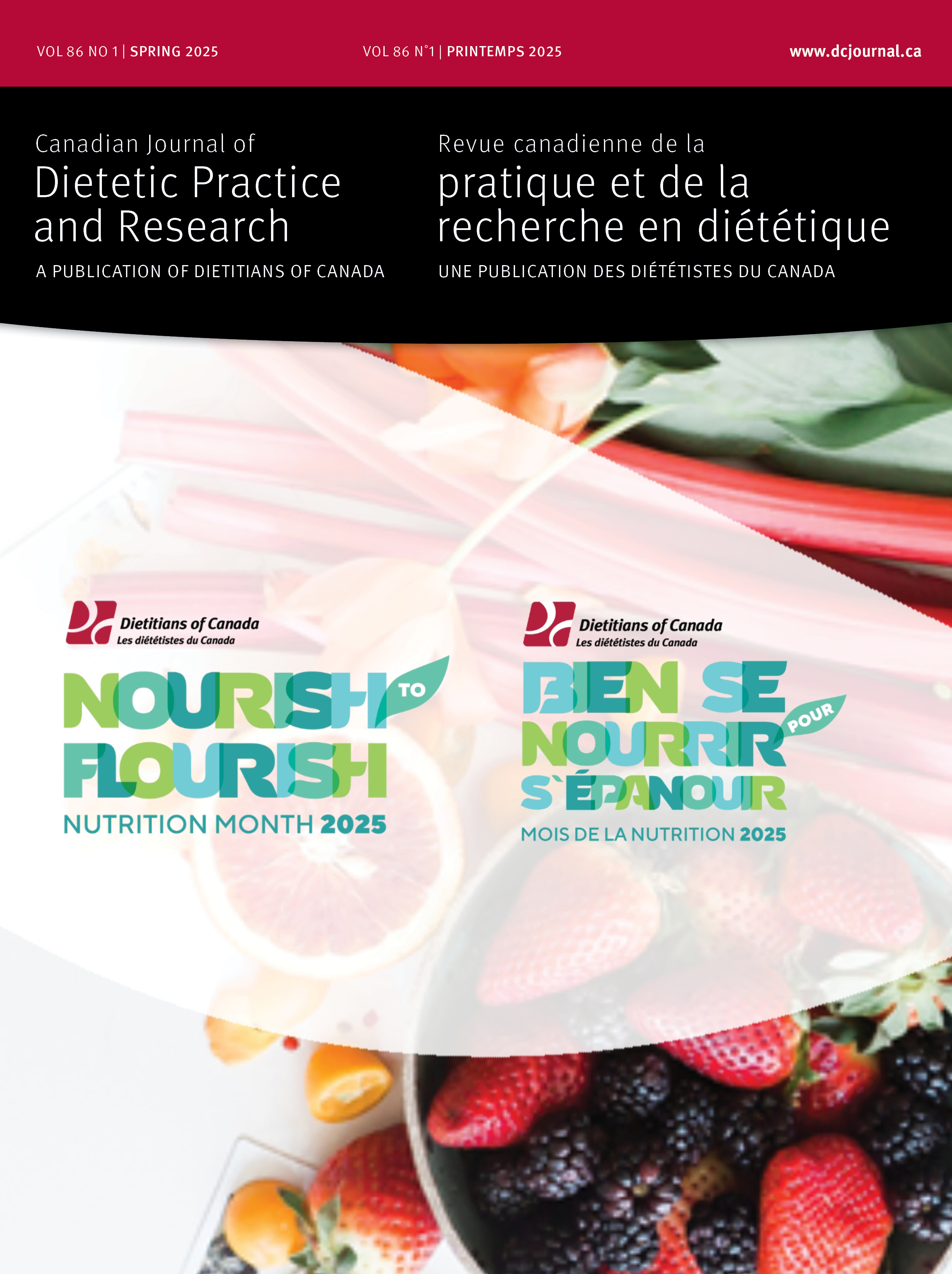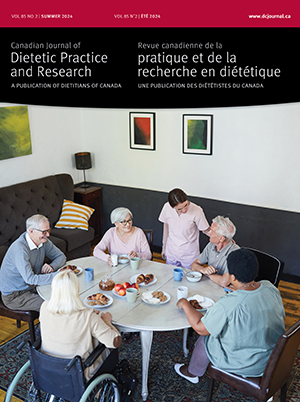Volume 85 • Number 3 • September 2024
Editor’s Message
Research
Purpose: The Canadian federal government has expressed an intention to work with provinces and territories to develop a national school food program (SFP). This study aimed to explore caregivers’ perception of attributes important to include in a future SFP.Methods: An online cross-sectional survey was conducted. Fifteen elementary schools from high, medium, or low median income neighbourhoods in Saskatoon were invited to participate. School principals sent a survey link to students’ caregivers. The 37-item survey included an item with 15 statements asking caregivers to rate the importance of various components of a SFP. Descriptive statistics and exploratory factor analysis were conducted.Results: A total of 510 caregivers completed the survey (response rate of 52%). The factor analysis indicated four key components of a future SFP: (1) learning opportunities on growing and preparing food, (2) offering healthy food following Canada’s Food Guide, (3) affordability of the meals offered, and (4) cultural adaptability of the meal program. Over 90% of caregivers thought providing healthy meals and ample time to eat meals to be very important.Conclusion: Our results indicate caregivers support multicomponent meal programs that, along with providing nutritious food, help children build healthy habits and sustainable food systems. These findings will help dietitians understand caregivers’ perspectives to inform the design of a national SFP.
Purpose: Patient dissatisfaction with hospital food is an important driver of poor food intake in hospitals. The objective of this study was to examine patient satisfaction with current menu offerings and explore patient preferences and values, in order to inform a patient-centred menu redesign.Methods: Between July and September 2021, a cross-sectional survey was distributed to inpatients receiving a lunch tray at Vancouver General Hospital, a large tertiary care centre in Vancouver, Canada. The survey was based on the Acute Care Hospital Foodservice Patient Satisfaction Questionnaire, with additional questions on food experience, factors impacting preferences for hospital meals, interest in plant-rich diets, and demographics.Results: The response rate was 5.5%, with 271 patients completing at least part of the survey. On a 5-point Likert scale, (5 – highest score; 1 – lowest score) satisfaction with food quality (mean = 3.09, p < 0.001) and the overall experience (mean = 3.54, p < 0.001) was lower than industry benchmark of 4, and qualitative feedback was generally negative. Open-ended responses indicated patients were interested in expanded cultural diversity in food provision, more fresh produce and better flavours, and were generally open to trying plant-rich foods.Conclusions: A number of opportunities for improvement were identified in this survey, which will inform an upcoming menu redesign in this institution.
OPEN ACCESS
Purpose: Our understanding of the influence of sugar intake on anthropometrics among young children is limited. Most existing research is cross-sectional and has focused on sugar-sweetened beverages. The study objective was to investigate longitudinal associations between young children’s total, free, and added sugar intake from all food sources at baseline with anthropometric measures at baseline and 18 months.Methods: The Guelph Family Health Study (GFHS) is an ongoing randomized controlled trial and a family-based health promotion study. Food records and anthropometric data were collected at baseline (n = 109, 55 males; 3.7 ± 1.1 y, mean ± SD) and 18 months (n = 109, 55 males; 5.1 ± 1.1 y) of the GFHS pilots. Associations between sugar intakes and anthropometrics were estimated using linear regression models with generalized estimating equations adjusted for age, sex, household income, and intervention status.Results: Total sugar intake was inversely associated with body weight at 18 months (P = 0.01). There was no effect of time on any other associations between total, free, and added sugar intakes and anthropometrics.Conclusions: Early life dietary sugar intakes may not relate to anthropometric measures in the short term. Further investigation into potential associations between dietary sugar intakes and anthropometric variables over longer time periods is warranted.
OPEN ACCESS
Purpose: The Food and Nutrition for Manitoba Youth (FANS) study examined dietary intakes, food behaviours, food security status, health indicators, and body mass index of a cohort of grade 9 students. This paper describes regional differences and similarities in dietary intake (food and nutrients) and quality of youth participants in the FANS study.Methods: Grade 9 students completed a web-based survey on dietary intakes (24-hour recall), food behaviours, self-reported health indicators, and sociodemographic variables. Nutrient intakes were compared with national guidelines and diet quality was assessed using a modified Healthy Eating Index.Results: A total of 1587 students participated from northern, rural, and urban regions in Manitoba. Northern and rural students had higher intakes of sugar, sodium, and saturated fat compared with urban. Northern students consumed fewer grain products compared to urban, and more servings of “other” foods compared with rural and urban. While most participants were classified into the “needs improvement” or “poor” Healthy Eating Index categories, significantly more northern participants were in the “poor” category.Conclusions: Most adolescents in the study are at nutritional risk; however, there are additional vulnerabilities for those in rural and northern communities. Dietitians can use results to advocate for and plan interventions to improve adolescent nutrition.
Purpose: To assess vitamin D, folate, vitamin B12, and iron status in Old Order Anabaptist (OOA) pregnant/postpartum women.Methods: Blood was analyzed for plasma 25 hydroxy vitamin D (25(OH)D), red blood cell (RBC) folate, serum vitamin B12, and iron status indicators. Dietary intakes (food and supplements) from 3-day estimated records were compared to Dietary Reference Intakes and Canada’s Food Guide (2007).Results: Fifty women participated in this descriptive cross-sectional study. Concentrations of 25(OH)D were low (<50 nmol/L for 20% and < 75 nmol/L for 63%); 42% had total vitamin D intakes < estimated average requirement (EAR). All women had RBC folate above the 1360 mmol/L cut-off. Nineteen percent had folate intakes <EAR; 80% had folic acid supplement intakes >upper limit. One woman had low serum vitamin B12 (<148 pmol/L); serum vitamin B12 was high (>652 pmol/L) for 24%. None had vitamin B12 intakes <EAR; intakes were high compared to the recommended dietary intake. One woman had low hemoglobin; 13% had ferritin <15 μg/L. Thirteen percent had total iron intake <EAR.Conclusions: Overall, dietary intake and serum micronutrient status of OOA pregnant and postpartum women in our study were similar to those reported in previous studies of Canadian women. While some women had low intakes of vitamin D and iron, most had high intakes of folate and vitamin B12. These findings provide guidance to ensure appropriate dietary and supplement intakes in this potentially vulnerable and rarely studied population.
Perspectives in practice
Individuals receiving hemodialysis are at increased risk of malnutrition; however, regular diagnosis of malnutrition using subjective global assessment (SGA) is time-consuming. This study aimed to determine whether the Canadian Nutrition Screening Tool (CNST) or the Geriatric Nutrition Risk Index (GNRI) screening tools could accurately identify hemodialysis patients at risk for malnutrition. A retrospective medical chart review was conducted for in-centre day shift hemodialysis patients (n = 95) to obtain the results of the SGA assessment and the CNST screener and to calculate the GNRI score. Sensitivity and specificity analyses showed only a fair agreement between the SGA and CNST (sensitivity = 20%; specificity 96%; κ = .210 (95% CI, -0.015 to .435), p < .05) and between the SGA and GNRI (sensitivity = 35%; specificity = 88%; κ = .248 (95% CI, .017 to .479), p < .05). There was no significant statistical difference between the accuracy of either tool in identifying patients at risk of malnutrition (p = .50). The CNST and GNRI do not accurately screen for risk of malnutrition in the hemodialysis population; therefore, further studies are needed to determine an effective malnutrition screening tool in this population.
OPEN ACCESS
Literature on dietary behaviours of the pediatric Crohn’s Disease (CD) population and the relationship between dietary intake and CD activity is limited. Three dietary indices were developed and tested to conduct dietary pattern analysis in pediatric patients with CD consuming a free diet following remission induction via exclusive enteral nutrition (n = 11). Index scores underwent descriptive and inferential analysis. The mean adjusted scores (out of 100) for the Pediatric Western Diet Index, Pediatric Prudent Diet Index, and Pediatric-Adapted 2010 Alternate Healthy Eating Index (PA2010-AHEI) were 29.82 ± 15.22, 34.25 ± 15.18, and 51.50 ± 11.69, respectively. The mean Western-to-Prudent ratio was 0.94 ± 0.55. A significant correlation (r = −0.71) and relationship (F[1, 9] = 9.04, P < 0.05, R2 = 0.501) between the Western-to-Prudent ratio and PA2010-AHEI was found. The results suggest participants were not following a Western or Prudent diet, and were consuming foods not captured by the indices. More research is needed to describe dietary intake of individuals with CD, validate dietary indices in diverse samples, and explore the utility of these indices in CD assessment and treatment. The co-authors hope this work will stimulate/inspire subsequent interprofessional, dietitian-led research on this topic.
OPEN ACCESS
Early learning and child care (ELCC) settings in Canada follow nutrition standards that outline food provisions, with many also encouraging responsive feeding practices that help to create a supportive environment for children. Caregivers who lack confidence in children’s ability to regulate their own intake, or those who feel stressed about mealtime, may unknowingly engage in less responsive feeding practices. The CELEBRATE Feeding Approach is a flexible framework, driven by behaviour change theory, that builds on previous definitions and concepts of responsive feeding in ELCC environments. Through this approach, there is an intentional focus on supporting early childhood educators to implement feeding practices that are more responsive. The approach incorporates 13 target educator behaviours related to the three overlapping categories of CELEBRATE language, CELEBRATE Mealtime, and CELEBRATE Play. These practices recognize and support the development of a child’s sense of autonomy, confidence, and self-regulation not only at mealtimes but also through play-based exploration and language that is used throughout the day around food and feeding. The goal is that children will be open to a wide variety of food, develop their self-regulation skills, and build the foundation for a positive relationship with food throughout their lifetime.
ICND Congress Abstracts
OPEN ACCESS
Every four years the International Confederation of Dietetic Associations (ICDA) hosts the International Congress of Nutrition and Dietetics. (ICND). In 2024, the ICND was held June 12- 14 in Toronto, Ontario, Canada. Informed by the overarching theme of “Rise to the Challenge”, the comprehensive program covered a wide range of topics, sharing the best of applied science, practice and training experiences in the field of nutrition and dietetics.This special article in the Fall issue of the Canadian Journal of Dietetics Practice and Research contains all abstracts accepted for presentation at ICND 2024 (oral abstracts, poster presentations, expert lectures, panel discussions, and workshops). The abstract peer-review and selection process was completed by the ICND 2024 Scientific Committee. All abstracts are published exactly as submitted without further review by the journal Editor or publisher.









